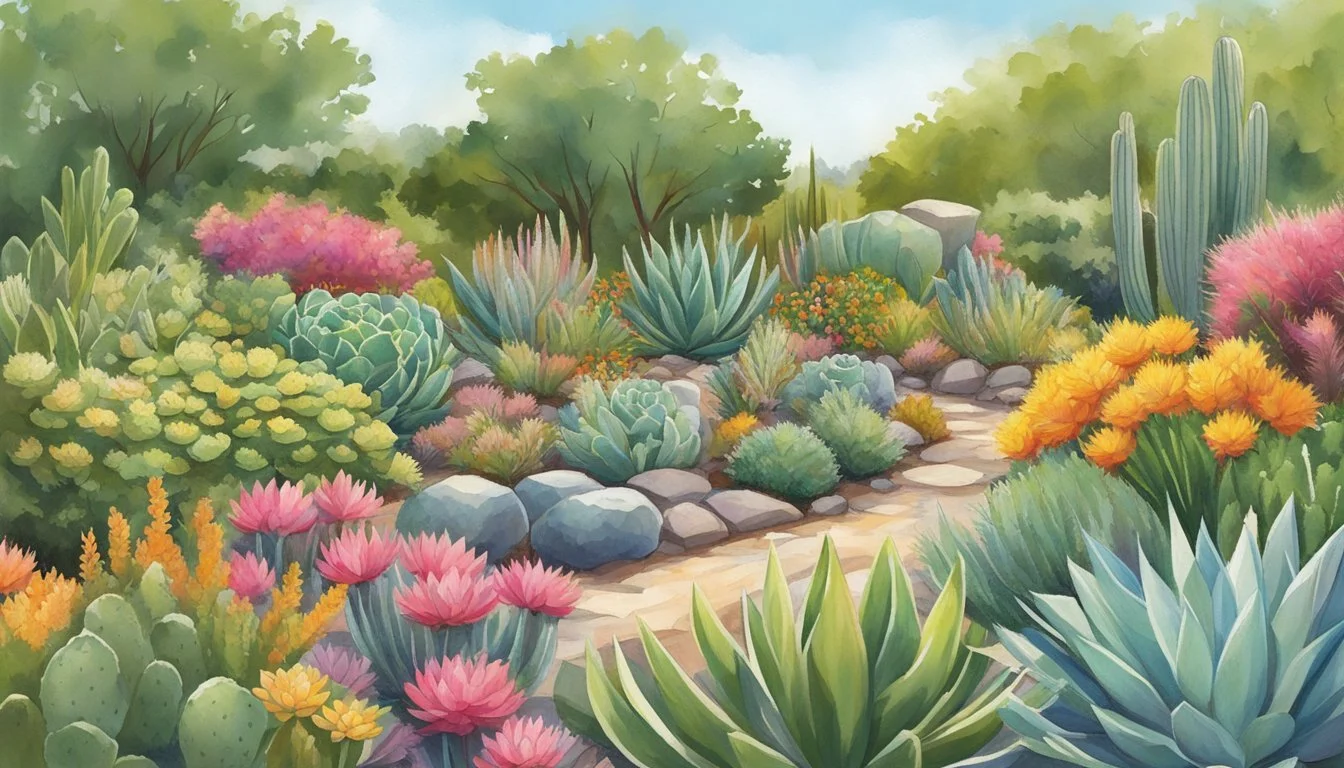Drought-Tolerant Plants in Connecticut
A Guide to Resilient Landscaping Choices
Drought-tolerant plants offer a sustainable solution for gardeners and landscapers in Connecticut, a state known for its varied climate and occasionally dry conditions. Incorporating plants that can withstand periods of low rainfall into a garden helps to conserve water and ensures green spaces remain vibrant even during droughts. The selection of species suitable for such conditions goes beyond mere survival, embracing aesthetics and local ecology in the garden design.
Many native species in Connecticut have developed adaptations to cope with water scarcity, making them ideal candidates for drought-resistant landscaping. For instance, the American hop hornbeam is a native tree celebrated for its resilience to drought once established, presenting a graceful addition to dry woodland settings. Native flowers and grasses, such as little bluestem and bearberry, also contribute to a water-wise garden, requiring minimal irrigation compared to non-native counterparts.
The cultivation of drought-tolerant plants is further supported by strategies that maximize water retention in soil, adding to their inherent ability to flourish with less water. Using native species not only respects the natural biodiversity of Connecticut but also tends to reduce the need for supplemental watering and the maintenance that more water-dependent plants would demand. The marriage of appropriate plant choices with considered landscaping techniques creates an efficient and visually appealing garden, benefiting both homeowners and the environment.
Understanding Drought-Tolerant Landscaping
Drought-tolerant landscaping integrates plants and gardening practices that reduce water usage and maintenance. Connecticut homeowners can create resilient gardens by understanding these concepts specifically tailored to their regional climate and soil conditions.
Benefits of Drought-Tolerant Plants
Drought-tolerant plants offer significant advantages for home landscapes in Connecticut. Firstly, they require less watering, reducing the water bill and conserving this vital resource. Secondly, these plants tend to be low-maintenance, sparing homeowners from frequent care. In the ecosystem, they support local fauna with their adaptive traits. By selecting appropriate plants, gardeners contribute not only to conservation efforts but also enhance the aesthetic value of their property.
Climate Considerations in Connecticut
Connecticut falls within hardiness zones 5 to 7, implying variable climate conditions across the state. Gardeners must consider plants that can withstand the regional climate, including cold winters and the possibility of drought during warmer months. Plants that thrive in full sun and can cope with the local climate without extensive water inputs are ideal for Connecticut's home landscape.
Soil Requirements for Drought-Resilient Gardens
The success of a drought-resilient garden in Connecticut begins with the soil composition. Gardens should aim for well-draining soil that retains enough moisture to support plant life without becoming waterlogged. Incorporating organic matter or compost can improve soil structure, particularly if dealing with poor soil. A balance between drainage and water retention is crucial for creating a thriving, drought-tolerant garden.
Designing with Drought-Tolerant Plants
Creating a drought-tolerant landscape in Connecticut not only conserves water but also offers a resilient and attractive addition to your home's curb appeal. Thoughtful selection of plants and strategic design are critical for a garden that thrives in the local climate.
Planning Your Drought-Resistant Garden Layout
Drought-tolerant landscaping in Connecticut begins with a well-considered plan that takes into account the state's unique mix of seasons. Garden layouts should optimize the site's natural advantages, leveraging shaded areas to minimize evaporation and planning for sunnier areas to feature plants that thrive in direct light. Paths and hardscape elements add structure to the garden while reducing water-dependent areas.
Selecting Colors and Textures
The aesthetic appeal of a garden lies in its colors and textures. When choosing plants for your Connecticut garden, look for a balance between vibrant flowering plants and the soothing green of foliage. Drought-tolerant flowers, such as coneflowers and black-eyed Susans, offer lively splashes of color, while ornamental grasses add soft textures and movement.
Incorporating Native Plants
Utilizing Connecticut native plants is a cornerstone of drought-tolerant landscaping. These plants are adapted to the local climate and soil conditions, requiring less water and maintenance. Incorporating species such as aster, goldenrod, and switchgrass ensures your garden is both environmentally friendly and in harmony with the surrounding Connecticut ecosystem.
Utilizing Ground Covers and Grasses
Ground covers and grasses play a pivotal role in conservation by protecting the soil from erosion and reducing water loss. Options such as creeping thyme and sedum are excellent choices for Connecticut gardens, serving as hardy, attractive ground covers. Grasses should be chosen for their resilience and ability to withstand dry conditions, with native species being particularly suitable for maintaining a sustainable landscape.
Popular Drought-Tolerant Plants for Connecticut
Connecticut's varied climate calls for garden choices that can withstand periods of limited rainfall. Let's explore some of the best-performing drought-tolerant plants suited to Connecticut's growing conditions.
Perennials and Annuals in Connecticut's Climate
For gardeners in Connecticut, choosing perennials and annuals that can handle dry spells without sacrificing beauty is important. Lavender, with its fragrant lavender flowers, thrives in full sun and is known for coping well with dry conditions. Growing up to two feet in height, this flowering plant is not only drought-tolerant but also provides a pop of color and a relaxing scent. Echinacea, commonly known as coneflower, is another perennial boasting pink or white flowers. It is resilient in full sun and attracts butterflies with its nectar-rich blooms.
Salvia (Sage): Adapting well to dry conditions, salvia comes in various species offering a range of colors, with some presenting striking blue or purple flowers.
Artemisia: Known for its silvery foliage, artemisia requires minimal water once established and can bring an interesting textural contrast to the garden.
Annuals: While many annuals require regular watering, varieties like the drought-tolerant Euphorbia can survive with less water, sporting unusual and striking flowers.
Shrubs and Ground Covers Suited for Connecticut
Moving to shrubs and ground covers, some species are particularly well-adapted to Connecticut's climate and can provide year-round interest with minimal water requirements. Bearberry (Arctostaphylos uva-ursi) is an excellent ground cover featuring evergreen leaves with red berries, suited for sandy and well-drained soils with lots of sunlight. Russian Sage (Perovskia) stands out with its height and airy spires of blue flowers, performing well in both drought and poor soil conditions.
Winterberry: Known for its vibrant red berries, winterberry is a native shrub that can tolerate wet soil and is a standout in the winter landscape of Connecticut.
Red Chokeberry: Flourishing in full sun to part shade, red chokeberry is appreciated for its adaptability, offering spring flowers, striking red fall foliage, and berries that persist into winter.
New England Aster (Aster novae-angliae): A native perennial that can serve as a low shrub, it showcases purple flowers and is a vital source of late-season nectar for pollinators.
Attracting Wildlife with Drought-Resistant Varieties
Connecticut's diverse wildlife can thrive in your garden with the strategic use of drought-resistant plants. These varieties provide essential resources while conserving water.
Plants Attractive to Pollinators and Birds
Native plants like Achillea millefolium (Yarrow) not only withstand dry conditions but also serve as nectar sources for butterflies and bees. This flowering plant thrives in full sun, with a spread that forms dense patches attractive to various insects. Similarly, the bright red flowers of Asclepias tuberosa (Butterfly Weed) are not only ornamental but are nectar-rich, drawing the attention of hummingbirds and acting as a host plant for butterfly larvae.
Incorporating ornamental grasses into mixed borders benefits the local ecosystem by providing cover for small mammals and insects, while colorful nectar-rich flowers create a vibrant palette that entices a variety of pollinators.
Supporting Local Ecosystems
Choosing plants that are native to Connecticut, such as Salvias, supports conservation efforts by maintaining an ecological balance. Their adaptability means they integrate well into local ecosystems, providing food, shelter, and breeding grounds for wildlife. By selecting plants accustomed to the region's climate, gardeners can ensure year-round support for birds, insects, and small mammals.
Integrating drought-tolerant plants propels gardeners to play a pivotal role in the conservation of water resources while fostering a thriving community of diverse species.
Maintenance and Care for Drought-Tolerant Flora
Proper maintenance and care enhance the resilience of drought-tolerant plants in Connecticut's diverse landscaping. These plants typically require less attention than others, but strategic practices can ensure their health and longevity.
Watering Techniques and Schedules
Drought-tolerant plants prefer deep, infrequent watering to encourage strong root development. Recommended practice involves providing a thorough soak, allowing water to penetrate 6-8 inches into the soil, followed by a period of drying. Ideally, one should water these plants in the early morning to reduce evaporation. For established plants, watering every 7 to 10 days during dry spells will maintain moisture without over-saturating the soil.
Fertilizing and Soil Amendments
These flora thrive in well-draining soil, often with higher sand composition. Amendments with organic matter can enhance soil structure, retaining adequate moisture and nutrients while still providing good drainage. Fertilizing is seldom necessary, but when needed, employ a slow-release, low-nitrogen option to avoid rapid, weak growth. Aim for fertilizers appropriate for acidic soil, which many drought-tolerant species favor.
Managing Pests and Diseases
Drought-tolerant plants are generally low-maintenance and less susceptible to pests and diseases. Still, vigilance is key. Minimize issues by ensuring proper plant spacing for air circulation and inspecting regularly for signs of distress. Utilize organic pesticides as a last resort, focusing more on preventative measures such as removing diseased foliage and avoiding overhead watering.
Seasonal Upkeep and Pruning
Pruning is vital to the health of drought-resistant plants, aiding in the removal of dead or diseased wood and promoting air circulation. Prune in late winter or early spring, depending on the plant's flowering cycle. In Connecticut, some might need protection from winter chill; mulch can help insulate roots against extreme temperatures. Conversely, seasonal upkeep may involve reducing mulch layers for the summer to prevent excess moisture and heat retention in the soil.
Environmental Impact and Conservation
In Connecticut, the introduction of drought-tolerant plants offers significant environmental benefits, including sustainable landscaping practices and support for local biodiversity.
Contribution to Sustainability
Drought-tolerant plants play a pivotal role in sustainable landscaping within Connecticut. These species require less water than other plants, leading to conservation of valuable water resources. They often have deep root systems that enhance soil structure and reduce erosion. Landscapers and gardeners can foster sustainability by including plants like the switchgrass and butterfly milkweed, which are highlighted in the Connecticut Coastal Planting Guide, allowing for eco-friendly gardens and public spaces with less reliance on irrigation and maintenance.
Incorporating drought-tolerant flora, as recommended by the University of Connecticut, also helps in mitigating the impacts of longer drought periods predicted for the area, which is a growing concern highlighted in their research about insect visitors to drought-resistant plants.
Role in Local Biodiversity
Drought-tolerant native plants are essential for maintaining Connecticut's ecosystem. They provide habitat and food sources for local wildlife, including birds, hummingbirds, and pollinators like butterflies and bees. For instance, native perennials such as the New England aster and goldenrod not only withstand dry conditions but also serve as vital nectar sources.
The New England Native Plants Initiatives highlights the importance of these plants in local ecology. They are integral in creating a balanced environment, as they are evolved to the region's conditions and serve as the foundation for a healthy ecosystem. The utilization of native, non-invasive plants in landscaping aids in the conservation of Connecticut’s diverse plant and animal life, enriching the ecosystem by providing a variety of fundamental resources for indigenous species.
Frequently Asked Questions
Drought-tolerant plants provide resilience and beauty for Connecticut gardens, ensuring successful growth despite unpredictable rainfall.
What are some popular drought-tolerant perennials for Connecticut gardens?
Perennials like sedum, Russian sage, and ornamental grasses are well-suited for Connecticut. These plants adapt well to the region's varying weather patterns and require minimal watering once established.
Which drought-tolerant shrubs thrive in Connecticut's climate?
Shrubs such as juniper and butterfly bush are robust, offering both aesthetic appeal and drought resistance suitable for Connecticut's climate.
Can you recommend any low-maintenance, drought-tolerant flowers suitable for Connecticut?
Connecticut gardens can benefit from drought-tolerant flowers like lavender and Black-eyed Susan, which provide vibrant colors and require minimal upkeep.
What are the best drought-tolerant shade plants for Connecticut landscapes?
For shaded areas, ferns and Hellebores are excellent choices. They thrive in cooler, shaded spots in the garden and are adept at handling periods without water.
Which evergreen plants are both drought-tolerant and suitable for Connecticut weather?
Evergreen plants such as yew and boxwood make for hardy, year-round greenery in Connecticut landscapes, coping well with dry spells.
What are the top performing drought-tolerant plants for full sun in Connecticut?
Plants like drought-tolerant annuals and perennials recommended by the University of Connecticut can perform exceptionally well in full sun conditions, with minimal watering needs once established.









